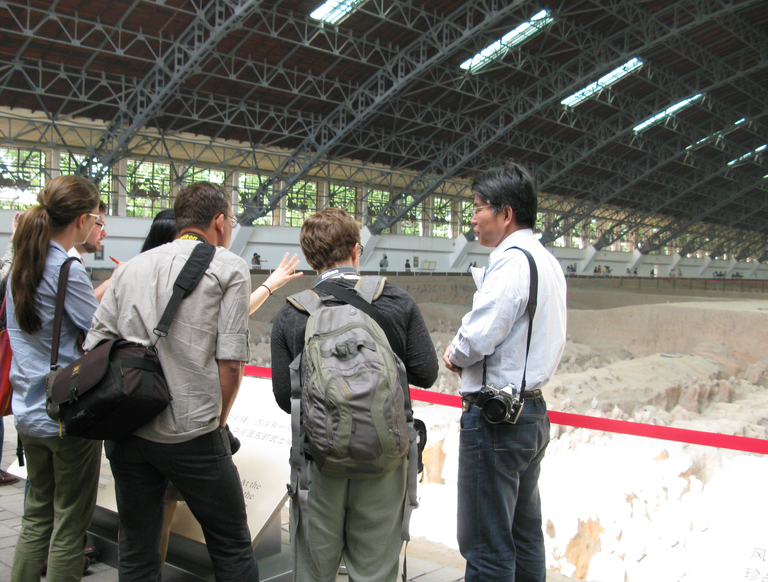Art, Archaeology, and the First Emperor: A Global Approach
This article first appeared in ISAW Newsletter 13, Fall 2015.
Lillian Tseng
Associate Professor of East Asian Art and Archaeology
 The ISAW team at Pit 1
The 1974 discovery in Xi’an, China, near the mausoleum of the First Emperor (r. 221-210 BCE) of an army of terracotta warriors surprised and dazzled the world. Over 8,000 life-size soldiers from three pits challenged the accepted notion that Chinese artisans had not paid attention to human form in art until the introduction of Buddhist sculpture in the third and fourth centuries of our era. Even after the discovery, scholars thought that the development of anthropomorphic art in the reign of the First Emperor was a Chinese phenomenon that had nothing to do with the rest of the world.
The ISAW team at Pit 1
The 1974 discovery in Xi’an, China, near the mausoleum of the First Emperor (r. 221-210 BCE) of an army of terracotta warriors surprised and dazzled the world. Over 8,000 life-size soldiers from three pits challenged the accepted notion that Chinese artisans had not paid attention to human form in art until the introduction of Buddhist sculpture in the third and fourth centuries of our era. Even after the discovery, scholars thought that the development of anthropomorphic art in the reign of the First Emperor was a Chinese phenomenon that had nothing to do with the rest of the world.
New discoveries at the site in the past decade, including particularly statues of entertainers, have called that view into question. Some specialists have seen these statues as having close connections to the art of the Hellenistic world. However, the potential interconnections between China and the Mediterranean world, presumably through Central Asia, cannot be properly understood and evaluated without the collaboration of specialists from all the related cultural areas. Therefore I am leading a multi-year research project that invites scholars in Chinese, Central Asian, and Greco-Roman studies to examine together the archaeological sites and finds in Xi’an and to exchange ideas and research results at NYU’s campuses in Shanghai and in New York. In addition, the project includes a series of methodological workshops that explore ways to tackle the complexity of “archaic globalization” in the ancient world. A core group of NYU faculty, both from ISAW and from other parts of the university, along with several advanced graduate students and faculty from other institutions, provide continuity through the years.
The project began with an on-site workshop in the Museum of the Mausoleum of the First Emperor at Lintong, approximately twenty miles east of Xi’an, China, in the summer of 2015. We took advantage of the permanent exhibitions that resulted from on-site preservation, including the renowned three pits of terracotta warriors and the lately acclaimed pit of entertainers. We also benefited from a special exhibition that featured many precious painted figurines, which gave us better ideas of how colors were used. We enjoyed the privilege of closely inspecting the figurines under conservation in Pit 1 and Pit K9901. Through extensive discussions with local archaeologists, we learned firsthand the on-going excavations and the updated understanding of the environment, the domain, and the structure of the mausoleum. Armed with the substantial observation and new knowledge from the field, the team will share preliminary thoughts in a workshop at NYU-Shanghai in 2016.
